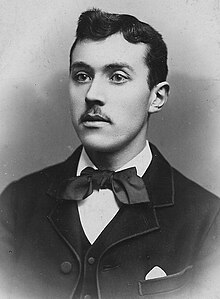James Hoey Craigie TD FRIBA (7 May 1870 – 30 March 1930) was a Scottish architect. He studied at the Glasgow School of Art. In 1894 he won the Alexander Thomson travelling scholarship which he spent in France and Italy. In 1905 he was made a partner in the firm Clarke & Bell, its name changing to Clarke & Bell & J H Craigie.[1][2][3]
James Hoey Craigie | |
|---|---|
 | |
| Born | 7 May 1870 Glasgow, Scotland |
| Died | 30 March 1930 (aged 59) Glasgow, Scotland |
| Alma mater | Glasgow School of Art |
| Occupation | Architect |
| Awards | Alexander Thomson travelling scholarship |
| Practice | Clarke & Bell & J H Craigie |
| Buildings | Grosvenor Building, Glasgow Corona Bar, Langside St Mary's Parish Church, Kirkintilloch Lewis's Department Store, Glasgow |
Significant works
editCraigie's significant work includes the domed roof and restaurant additions to the Grosvenor Building, 72–80 Gordon Street (1902–07);[4][5][6][7][8][9][10][11] Art Nouveau remodelling of early 19th century tenement, 186–188 Argyle Street (1908);[12] the reconstruction of the Justiciary Buildings in Glasgow (1910–13);[13][14][15] Corona Bar, Langside (1912–13);[16][17] and St Mary's Parish Church, Kirkintilloch (1912–14).[18]
In 1929, Craigie was commissioned to design a new Department Store with 380,000 square feet (35,000 m2) of shopping space for the firm of Lewis's Limited, who had bought over an old Glasgow firm, John Anderson's "Royal Polytechnic" known to Glaswegians as "The Poly".[19][20][21] He worked closely with Frederick Marquis (later Lord Woolton) who subsequently became Managing Director of Lewis's. They were most thorough in their planning and Craigie and Marquis toured the country inspecting all department stores with the object of ensuring that the new store would embrace everything that was good in its construction. They visited London, Liverpool, Manchester and Birmingham and incorporated all the knowledge acquired into the plans for the Glasgow Store. Craigie's biggest difficulty was to find a sure method of keeping the River Clyde out of the basement.[22][23][24]
Military service
editCraigie served as a captain in the Royal Engineers during the First World War, holding a commission in the 7th Battalion of the Highland Light Infantry from 1908, and was awarded the Territorial Decoration in 1917.[25][26][27]
Personal life
editCraigie was a member of Cathcart Parish Council from 1913 and was its chairman in 1922–23. He was married three times, and had four children with his second wife. He died of liver cancer on 30 March 1930.[1]
References
edit- ^ a b "James Hoey Craigie Biography". Dictionary of Scottish Architects. Retrieved 14 April 2009.
- ^ Tim Gardner – Webmaster. "Glasgow – City of Sculpture – James Hoey Craigie Biography". Glasgowsculpture.com. Retrieved 11 January 2012.
- ^ David Goold. "Dictionary of Scottish Architects – Clarke & Bell & J H Craigie". Scottisharchitects.org.uk. Retrieved 11 January 2012.
- ^ David Goold (27 October 1907). "Dictionary of Scottish Architects – Grosvenor Building". Scottisharchitects.org.uk. Retrieved 11 January 2012.
- ^ Guide Author. "Grosvenor Building by Alexander Thomson and J H Craigie". Glasgowguide.co.uk. Archived from the original on 22 February 2012. Retrieved 11 January 2012.
{{cite web}}:|author=has generic name (help) - ^ Guide Author. "Grosvenor Building – Domed Roof Section – J H Craigie 1902–07". Glasgowguide.co.uk. Retrieved 11 January 2012.
{{cite web}}:|author=has generic name (help) - ^ Grosvenor Building, Gordon Street, Glasgow
- ^ "Burrell Collection Photo Library, 1955 Survey – Grosvenor Building". Theglasgowstory.com. Retrieved 11 January 2012.
- ^ "Royal Commission on the Ancient and Historical Monuments of Scotland – Grosvenor Building". Canmore.rcahms.gov.uk. Retrieved 11 January 2012.
- ^ "Royal Commission on the Ancient and Historical Monuments of Scotland – Grosvenor Building". Canmore.rcahms.gov.uk. Retrieved 11 January 2012.
- ^ "Grosvenor Building, 72–80 Gordon Street, Glasgow". Scran.ac.uk. 5 January 1998. Retrieved 11 January 2012.
- ^ Historic Environment Scotland. "186, 188 Argyle Street, The Grant Arms (Category B Listed Building) (LB32950)". Retrieved 20 March 2019.
- ^ David Goold. "Dictionary of Scottish Architects – Justiciary Court Houses". Scottisharchitects.org.uk. Retrieved 11 January 2012.
- ^ Historic Environment Scotland. "Justiciary Courts, excluding extension to Mart Street, 212 Saltmarket Street, Glasgow (Category A Listed Building) (LB32844)". Retrieved 20 March 2019.
- ^ "Glasgow Green Court-house (now known as 'High Courts'), reconstructed as Justiciary Courts by J H Craigie". Scran.ac.uk. 5 January 1998. Retrieved 11 January 2012.
- ^ David Goold. "Dictionary of Scottish Architects – Corona Bar". Scottisharchitects.org.uk. Retrieved 11 January 2012.
- ^ "Langside Heritage Trail – 21. Corona Bar (page 31)" (PDF). Retrieved 11 January 2012.
- ^ David Goold. "Dictionary of Scottish Architects – St Mary's Parish Church, Kirkintilloch". Scottisharchitects.org.uk. Retrieved 11 January 2012.
- ^ David Goold (9 December 1932). "Dictionary of Scottish Architects – Lewis's Royal Polytechnic". Scottisharchitects.org.uk. Retrieved 11 January 2012.
- ^ South Glasgow Heritage & Environment Trust – Anderson's Royal Polytechnic[dead link]
- ^ "Achievements and Archive Photographs of this Great Scottish City: Argyle Street". Glasgow History. 25 February 2010. Retrieved 11 January 2012.
- ^ Some History of the Craigie Family, William Thom Craigie
- ^ Historic Environment Scotland. "65-117 (Odd Nos) Argyle Street, known as No 65 Argyle Street, former Lewis's Department Store (Category B Listed Building) (LB32609)". Retrieved 20 March 2019.
- ^ "Postcard showing Lewis's Department Store". Retrieved 11 January 2012.
- ^ "The London Gazette, 25 September, 1908". The London Gazette. 25 September 1908. Retrieved 11 January 2012.
- ^ "The London Gazette, 20 October, 1914" (PDF). Retrieved 11 January 2012.
- ^ "The London Gazette, 11 September, 1917" (PDF). Retrieved 11 January 2012.